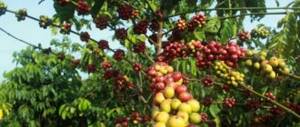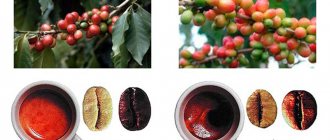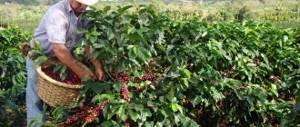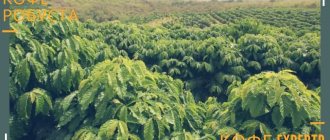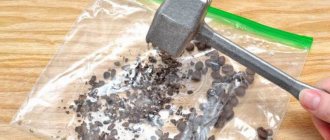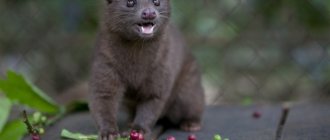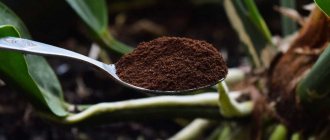General information
The foliage of the coffee tree is not small, fleshy and has a greenish tint. Flowering begins and the plant produces an umbrella-like inflorescence consisting of approximately 76 flowers.
The flowers are white on small roots and appear on young annual stems. The fruits of the plant consist of two seeds, round in shape, initially having a yellow tint, turning into green. And the ripe fruits of the coffee tree are red. When the fruit ripens, it is covered with a crust on the outside, and inside is filled with sweetish, slightly sour pulp and a pair of seeds about 13 mm in length.
Home-grown coffee trees have beneficial properties. It can purify the air from harmful substances, increase and improve a person’s energy capabilities, reduce and relieve stress and put the nervous system in order.
Growing a coffee tree from beans
Growing an entire coffee tree at home from a grain is a longer process, but no less exciting. It is necessary to purchase Arabian coffee beans. Not fried or over-dried.
Using pliers, you need to compress the grains so that a crack appears on them or make a very careful cut with a very sharp knife. This procedure will help the coffee beans hatch and germinate faster.
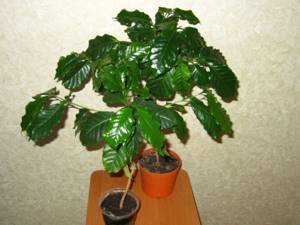
Next, you need to follow a certain algorithm:
- Soak cracked seeds in a growth stimulating solution overnight (or 24 hours).
- Plant the seeds in a pot with excellent quality drainage and a special very loose and moist mixture of acidic soil about 3 cm deep.
- Water.
- Cover with polyethylene or a transparent glass saucer.
- Place in a warm room.
- Once every 2 weeks you need to remove the covering, remove condensation and ventilate.
- The first sprouts may hatch in about 2 months.
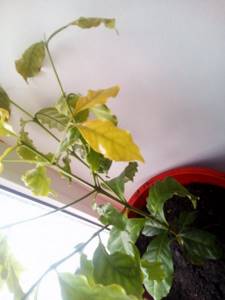
Types of coffee trees
The Arabian coffee variety , popular for growing at home, is a compact tree. The leaves are shaped like an elongated ellipse with a dark olive tint, glossy on the outside and pale on the inside. The inflorescences are small, about 2 centimeters in diameter, collected in a bouquet. The size of the inflorescences directly depends on the growing conditions.
Once opened, flowers remain fresh for only a few hours. But the buds gradually open, not all at once. After the inflorescences fade, the fruit ripens in the form of a berry; when ripe it has a burgundy hue. Ripening occurs approximately 8 months after pollination. The paired fruits resemble round beans. This species reaches a height of up to 5 meters.
Coffee dwarf Nana is a neat plant, reaching a height of about 85 cm. It blooms profusely and subsequently bears fruit well at home. The tree can be given the desired design by trimming and pinching the tops of the plant.
Liberian coffee is also grown indoors. Its ripe fruits have a scarlet or sunny slightly orange tint. The length of its leaves reaches up to 40 cm, and the height is adjusted and the required shape is formed by trimming the crown of the plant. The inflorescence has a light shade and large fruits - berries.
Coffee tree at home - dream or reality
Since the fragrant berries conquered the hearts of gourmets around the world, widespread cultivation of the exotic plant has begun. At home, with proper care, the coffee tree looks very attractive and can reach up to 2 m in height. In a pot it quickly adapts to the room, but begins to bloom after 3-4 years.
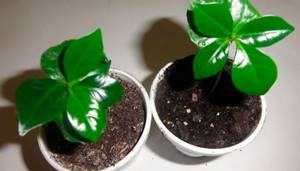
It is necessary to maintain optimal conditions for the plant:
- The room should be spacious, sunny, with an influx of fresh air. Windows on the east or west side are suitable. The exotic plant does not get along with others, so you will have to allocate separate apartments.
- Light is only diffused. In direct sunlight, the leaves wrinkle and turn yellow, and lack of lighting impairs growth. It is advisable to select the room once - the plant cannot be moved.
Coffee is grown using cuttings or fresh seeds, which can be purchased in the store. At home, Arabian and Liberian varieties take root, as well as the dwarf coffee plant Nana. A coffee bush will decorate the interior, and during the flowering period it will fill the room with a pleasant aroma. From one plant you can get up to 500 g of grains, which experienced gardeners can already boast of.
Caring for a coffee tree at home
The plant does not tolerate drafts and temperature changes. With proper care, you will enjoy fresh homemade coffee all year long.
The coffee tree prefers abundant, diffused lighting. The optimal location would be the southern part of the room. Constant ventilation is required in winter and preferable cultivation on loggias or terraces in the warm season. During the heating season, it is necessary to place the plant away from the radiator to avoid drying out the tips of the leaves. If there is insufficient lighting, it is necessary to use an artificial lamp.
The air temperature for the plant in summer should not exceed 25 degrees, and in winter it should not drop below 15 degrees. If you do not comply with the temperature conditions, the plant may lose its leaves and drop its buds.
The plant prefers regular spraying, and in the summer the plant needs to have a warm shower, this helps well with growth and active flowering. The humidity in the room should be high.
Watering in the summer is regular, allowing only one centimeter of the soil layer to dry, and in winter it should be reduced by one centimeter per week. Water for irrigation should be soft and settled, free of limescale, otherwise the plant may begin to hurt.
Arabica coffee at home: care, placement and lighting
To grow a good coffee tree, you must adhere to the following basic rules:
- Choose a location for the plant on the south, southwest or southeast side.
- Creating maximum lighting (with a lack of light, growth slows down and fruiting is delayed) - in the winter months, the flower is placed on the warmest southern side of the house; when cold and cloudy days set in, it is necessary to turn on fluorescent lamps.
- In this case, the coffee plant must be protected from direct sunlight, but during the period of formation of inflorescences it needs a lot of sunlight (after setting the fruit, it is shaded).
- You cannot turn the pot with the tree, otherwise only leaves will grow on it.
- The optimal temperature in the spring-summer months is +22-24 °C, in winter it can be lowered to +16-18 °C.
- For irrigation, settled water at room temperature is used.
- It is necessary to maintain high air humidity by regularly spraying the leaves, and it is also recommended to pour water into a tray with pebbles.
- The coffee tree does not like turns and rearrangements: with a slight change in the lighting angle by 30-40°, the plant may shed its leaves and stop flowering.
- When moving a plant to another place, it is necessary to prepare it in advance by covering it with gauze so that it is easier for it to adapt to the new lighting.
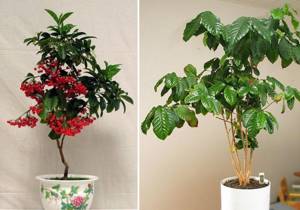
Coffee tree diseases at home
- Why do the leaves of a coffee tree dry out ? The reason may be low humidity in the room and dry air. It is necessary to increase spraying and watering.
- Parasites can also attack the coffee tree, such as sooty fungus, scale and mealybug . Cobwebs and a white coating appear on the plant. You can get rid of them using a soap solution, after first destroying the infected leaves.
- Why do the leaves of the coffee tree turn yellow and begin to discolor . The reason for this is insufficient soil acidity.
- Why do the leaves of a coffee tree fall off and brown spots appear ? This indicates a lack of soil moisture.
- Necrosis of coffee tree leaves - occurs as a result of a lack of phosphorus and potassium, lack of light or dry air in the room. A sudden change in temperature in the room may also be the cause. With insufficient phosphorus fertilization, the plant slows down in development and leads to yellowing and falling leaves.
Home care
Arabica does not require specific conditions for maintaining a home, but there are still a number of features that need to be taken into account.
We bought a coffee tree seedling: what to do?
In order for the coffee to start growing, you need to transplant the seedling from the shipping container. Many times, flower growers have spoken negatively about the quality of the substrate that is used to fill pots for transporting plants.
Often the soil is oversaturated with microelements so that the bushes have a “marketable” appearance. This is not bad for sale, but such soil is not suitable for further cultivation.
Temperature
Provide the plant with proper temperature conditions without drafts or sudden changes. It is optimal to maintain air temperatures from 22 to 30 °C in summer, and from 12 to 16 °C in winter.
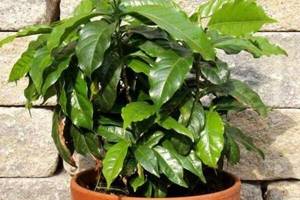
Spraying
In summer, when the air temperature is high, Arabica may lack moisture, so the plant needs to be sprayed regularly. It is better to take settled water at room temperature.
Once a month, it is recommended to add wood ash to prevent diseases. In winter, if the coffee is not standing close to the radiator, it is better to stop spraying.
Lighting
The plant is photophilous, but does not require direct sunlight at home. A bright diffused light flux is quite suitable.
The length of daylight is more important: it should be at least 10 hours. If there is not enough natural light, the bush will need to be illuminated using phytolamps.
Watering
You need to water the coffee often, but do not allow water to stagnate in the pot. In winter, watering is reduced to once a week.
Important! The earthen clod must not be allowed to dry out.
Pot
The flowerpot is selected in proportion to the root system, but with a small margin. If the container is too large, the soil will turn sour very quickly and the bush will rot. In a pot that is too small, the coffee will stop growing and may even lose its leaves.
Priming
Arabica prefers loose, breathable soils with an average acidity level of about 7 pH. For self-mixing you will need in equal parts:
- purified river sand;
- peat;
- humus;
- turf land.
A ready-made substrate in a flower shop will be no worse.
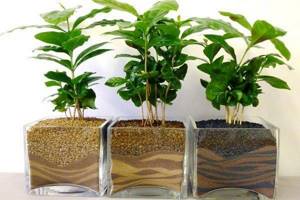
Feeding and fertilizer
Coffee needs regular fertilization; special attention should be paid to the frequency of fertilizing during periods of flowering and active growth of the bush:
- In the spring, nitrogen fertilizers are applied - this stimulates the growth and development of the green mass of the tree.
- In summer, phosphorus-potassium complexes are needed approximately once every 10 days.
- In the fall, you can feed the bush with potassium supplements.
Attention! In winter, feeding is stopped.
Transfer
A young plant requires frequent annual replanting, but once Arabica reaches three years of age, the frequency of replanting is reduced to once every 3–4 years.
However, every year you need to update the top layer of soil in the pot, as well as add organic fertilizers during replanting to plants that should bloom soon.
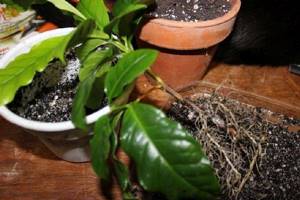
Trimming
You can form a coffee crown through regular pruning, but more often this way the natural growth of the bush is stopped at the desired height. Sanitary pruning of dry or damaged branches is carried out seasonally.
Rest period
In winter, it is recommended to give Arabica a rest. How to care for the bush during this period:
- The temperature is reduced to 12...15 °C.
- The number of waterings is reduced to once a week, but if the soil is clearly drying out, you need to water more often, but without being overzealous.
- Spraying is stopped and fertilizers are not applied.
- You can move the coffee pot into the shade, but then you need to organize additional lighting for several hours a day.
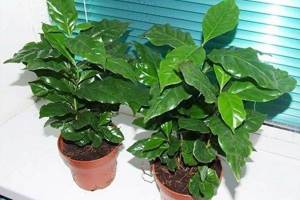
Is it possible to leave without care while on vacation?
To prevent the plant from dying during the owner’s vacation, you need to take some precautions:
- The inflorescences and fruits will have to be removed from the plant, since more moisture is required during the period of flowering and fruit set.
- You need to pinch the tops of growing shoots and stop their growth for a while.
- To protect the coffee from drying out, you can put a simple automatic waterer in the pot from a plastic bottle or place the pot with the plant on a moistened phytomat, which will provide comfort to the plant.
Interesting! The factory automatic watering system will also help out. Don't forget to test it before your trip so you can be sure that it works without interruption.

